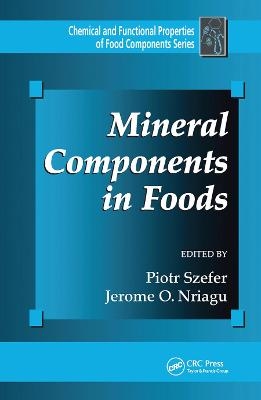
Mineral Components in Foods
Seiten
2019
CRC Press (Verlag)
978-0-367-45333-6 (ISBN)
CRC Press (Verlag)
978-0-367-45333-6 (ISBN)
Mineral Components of Food presents the state of knowledge on the distribution, speciation, and interaction of mineral components and contaminants in different raw materials and products including animal and plant products, honey, sweets, and wine, as well as from processing, packaging, and handling. With numerous tables clearly
Recent studies have raised concerns about the health effects of dietary exposure to trace elements. An estimated 40 percent of the world's population suffers from developmental and metabolic functional disorders due to trace element deficiencies. Conversely, there is an established link between excess intake of mineral components and diseases of the endocrine, kidney, liver, cardiovascular, and skeletal system. It has become crucial that food chemists understand the origin, function, bioavailability, and interactions of mineral components in food.
Mineral Components in Foods presents the state of knowledge on the distribution, speciation, and interaction of mineral components and contaminants inherent in different raw materials and products, as well as acquired during processing, packaging, and handling. With contributions written by some of the foremost food researchers in the world, this book considers the analysis of mineral components in food, the recent advancements in analytical techniques including statistical multivariate approaches to confirm authenticity based on mineral composition, and the quality control practices that ensure consistent and accurate data. The functional role of a number of minerals is addressed along with the effects of their deficiency or excess on the body, their interactions with other minerals, and their changes during storage and processing. Specifically, the authors examine mineral distribution in certain animal and plant products including confections, honey, wine and beer. A considerable portion of the book is devoted to the contamination of foods and food supplements by metals, metalloids and radionuclides, from packaging containers as well as a variety of environmental pathways.
With numerous tables and figures clearly expressing a wealth of detailed data, Mineral Components in Foods provides food chemists, quality control professionals, nutritionists, and students in these fields with an invaluable resource to t
Recent studies have raised concerns about the health effects of dietary exposure to trace elements. An estimated 40 percent of the world's population suffers from developmental and metabolic functional disorders due to trace element deficiencies. Conversely, there is an established link between excess intake of mineral components and diseases of the endocrine, kidney, liver, cardiovascular, and skeletal system. It has become crucial that food chemists understand the origin, function, bioavailability, and interactions of mineral components in food.
Mineral Components in Foods presents the state of knowledge on the distribution, speciation, and interaction of mineral components and contaminants inherent in different raw materials and products, as well as acquired during processing, packaging, and handling. With contributions written by some of the foremost food researchers in the world, this book considers the analysis of mineral components in food, the recent advancements in analytical techniques including statistical multivariate approaches to confirm authenticity based on mineral composition, and the quality control practices that ensure consistent and accurate data. The functional role of a number of minerals is addressed along with the effects of their deficiency or excess on the body, their interactions with other minerals, and their changes during storage and processing. Specifically, the authors examine mineral distribution in certain animal and plant products including confections, honey, wine and beer. A considerable portion of the book is devoted to the contamination of foods and food supplements by metals, metalloids and radionuclides, from packaging containers as well as a variety of environmental pathways.
With numerous tables and figures clearly expressing a wealth of detailed data, Mineral Components in Foods provides food chemists, quality control professionals, nutritionists, and students in these fields with an invaluable resource to t
Szefer, Piotr; Nriagu, Jerome O.
Mineral Components in Food - Analytical Implications, Speciation of Mineral Components in Food-Analytical Implications, Criteria of Evaluation of Food Elements Analysis Data, Chemometric Techniques in Analytical Evaluation of Food Quality, Functional Role of Some Minerals in Foods, Mineral Components in Foods of Animal Origin and in Honey, Mineral Components in Food Crops, Beverages, Luxury Food, Spices, and Dietary Food, Elemental Content of Wines, Heavy Metals in Food from Packaging, Pollutants in Food - Metals and Metalloids, Pollutants in Food - Radionuclides, Assessment of Exposure to Chemical Pollutants in Food and Water, Metal Contamination of Dietary Supplements
| Erscheinungsdatum | 03.12.2019 |
|---|---|
| Verlagsort | London |
| Sprache | englisch |
| Maße | 156 x 234 mm |
| Gewicht | 453 g |
| Themenwelt | Medizin / Pharmazie ► Gesundheitsfachberufe ► Diätassistenz / Ernährungsberatung |
| Naturwissenschaften ► Biologie | |
| Technik ► Lebensmitteltechnologie | |
| ISBN-10 | 0-367-45333-9 / 0367453339 |
| ISBN-13 | 978-0-367-45333-6 / 9780367453336 |
| Zustand | Neuware |
| Haben Sie eine Frage zum Produkt? |
Mehr entdecken
aus dem Bereich
aus dem Bereich
Indikation, Diagnostik, Therapie
Buch (2024)
Thieme (Verlag)
CHF 109,95
Unter Mitarbeit von Walter Burghardt
Buch | Softcover (2020)
Urban & Fischer in Elsevier (Verlag)
CHF 78,40


